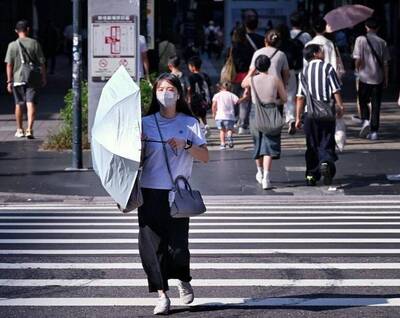A government program to develop solar energy has harmed farmers and threatens Taiwan’s food security, a group of academics said yesterday.
Taiwan’s land use laws have been steadily deregulated to facilitate photovoltaic construction since 2015, but there has been a steady trend away from the principle of sustainable development, the academics said in a petition, which had garnered 80 signatures.
The government must establish clear standards and procedures to select sites for solar installations to minimize the impact on farmers’ and fishers’ livelihoods, the environment and food security, the petition said.

Photo: Taipei Times file
Regulations give officials “virtual carte blanche” to declare farmland to be unsuited for agriculture, National Chung Kung University (NCKU) professor of urban planning Huang Wei-ju (黃偉茹) said.
The land is rezoned for use as solar farms with almost no factual basis, Huang said.
For example, 500 hectares designated as agriculture-only in Changhua County’s Dacheng Township (大城) was rezoned to permit photovoltaic construction, despite 89 percent of the land being intensively cultivated, she said.
Taiwan needs 132,000 to 570,000 hectares for green energy installations to achieve its 2025 target of 40 to 80 gigawatts generated from renewable sources, NCKU professor of urban planning Chao Tsu-yuan (趙子元) said.
That would require a comprehensive rethinking of national land use plans, a process that the government has not gone through yet, Chao said.
Failure to address controversies arising from the selection of solar energy sites would complicate implementation of zoning plans over the next two years, National Chengchi University (NCCU) assistant professor of land economy Tai Hsiu-hsiung (戴秀雄) said.
Green energy zones should be established under the Electricity Act (電業法) and Renewable Energy Development Act (再生能源發展條例), not extemporized by executive order, Tai said.
The effects of renewable energy installations should be more extensively examined in environmental impact assessments, he said.
It would be a mistake for Taiwan to fixate on net zero carbon emissions at the expense of other considerations, or reduce the challenge of mitigating climate change to merely installing renewable energy installations, National Taipei University professor of urban planning Liao Kuei-hsien (廖桂賢) said.
Rushing to build solar and wind farms without adequate planning would lead to a host of long-term problems, including loss of biodiversity and food production, Liao said.

Three Taiwanese airlines have prohibited passengers from packing Bluetooth earbuds and their charger cases in checked luggage. EVA Air and Uni Air said that Bluetooth earbuds and charger cases are categorized as portable electronic devices, which should be switched off if they are placed in checked luggage based on international aviation safety regulations. They must not be in standby or sleep mode. However, as charging would continue when earbuds are placed in the charger cases, which would contravene international aviation regulations, their cases must be carried as hand luggage, they said. Tigerair Taiwan said that earbud charger cases are equipped

Foreign travelers entering Taiwan on a short layover via Taiwan Taoyuan International Airport are receiving NT$600 gift vouchers from yesterday, the Tourism Administration said, adding that it hopes the incentive would boost tourism consumption at the airport. The program, which allows travelers holding non-Taiwan passports who enter the country during a layover of up to 24 hours to claim a voucher, aims to promote attractions at the airport, the agency said in a statement on Friday. To participate, travelers must sign up on the campaign Web site, the agency said. They can then present their passport and boarding pass for their connecting international

WEATHER Typhoon forming: CWA A tropical depression is expected to form into a typhoon as early as today, the Central Weather Administration (CWA) said yesterday, adding that the storm’s path remains uncertain. Before the weekend, it would move toward the Philippines, the agency said. Some time around Monday next week, it might reach a turning point, either veering north toward waters east of Taiwan or continuing westward across the Philippines, the CWA said. Meanwhile, the eye of Typhoon Kalmaegi was 1,310km south-southeast of Oluanpi (鵝鑾鼻), Taiwan’s southernmost point, as of 2am yesterday, it said. The storm is forecast to move through central

Taiwan sweltered through its hottest October on record, the Central Weather Administration (CWA) said yesterday, the latest in a string of global temperature records. The main island endured its highest average temperature since 1950, CWA forecaster Liu Pei-teng said. Temperatures the world over have soared in recent years as human-induced climate change contributes to ever more erratic weather patterns. Taiwan’s average temperature was 27.381°C as of Thursday, Liu said. Liu said the average could slip 0.1°C by the end of yesterday, but it would still be higher than the previous record of 27.009°C in 2016. "The temperature only started lowering around Oct. 18 or 19